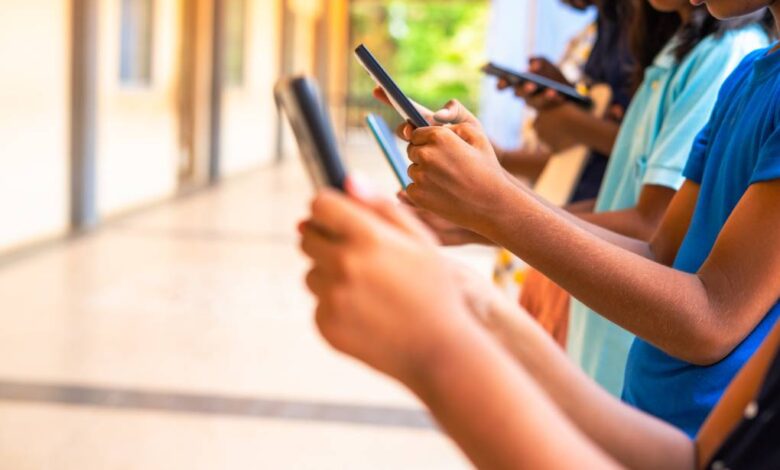Do Cellphone Bans in Middle School Work? It’s Complicated.

This year, Roosevelt expanded the policy to cover all electronics, including Google Chromebooks when not directly in use in a classroom. Additionally, the policy allows no room for warnings. Once a student’s electronic is spotted by a teacher or administrator, it is placed in the front office for the day. Students collect confiscated phones after school. This eliminates power struggles between teachers and students, according to Leicham.
Math teacher Melanie Buntichai said that it was a challenge for individual teachers to enforce their own classroom cellphone policies before the ban. If she engaged with a student who was using their phone inappropriately in class it could take up to ten minutes away from class time. Since Roosevelt implemented a schoolwide policy, “the students don’t fight back as much,” and interruptions became less time consuming, she said.
Leicham said students interact with each other more during lunchtime now. “It’s nice to see them, you know, being kids; hanging out with each other,” she said.
Roosevelt requires Common Sense Media’s digital citizenship lessons for students during advisory classes. According to Leicham, for the 2024-25 school year, Roosevelt aims to have students complete four lessons. The school also provides Common Sense Media resources for parents that covers appropriate and responsible tech use.
Student and parent responses
While parents have been on board with the electronics policy at Roosevelt, students have been harder to win over. Leicham said that transparency helps when explaining to students why smartphones and other devices don’t belong on campus. “Middle school is the time to build relationships with others,” and middle schoolers “need less screen time and more interaction with others,” Leicham said.
Psychologist Jacqueline Nesi thinks there is some truth to this. But “it’s not always the case that when students are using screens in general, that they are not socializing at all,” said Nesi, who studies the effects of technology on children. Increased focus on social interactions is a hallmark of early adolescent development, according to Nesi. However, when it comes to fitting in, smartphones can be both a source of disconnection and connection for middle schoolers. On one hand, a student can feel left out if they don’t have access to the same technology that their peers do. On the other hand, a student who feels “marginalized in their offline community” might find belonging through technology “even if it’s in an online environment,” said Nesi.
Like it did for Lindsey, Roosevelt’s cellphone policy attracted Eiko Sugano to the school. She also hoped to enroll her child there for sixth grade, but he ended up at another school further down on their lottery list. For Sugano, a full cellphone and electronics ban is what initially drew her to Roosevelt. “It was definitely one of my top factors,” she said. Sugano’s son does not have a cellphone. She prefers that he engages in-person rather than on a device, and learns to navigate everyday challenges, like missing a bus, without the help of a smartphone.
Kids need “increasing independence as they age [and] there’s value in giving them opportunities to solve problems,” said Nesi. There is no one-size-fits-all approach to parenting decisions about which devices to allow adolescents to use and when, she added.
Lindsey held an on-campus and online community conversation for families about cellphone and electronics policies at her child’s elementary school last year. “Parents are feeling so alone in this,” she said. Coming together as a school community provided a much needed space for “information sharing between parents about how they’re navigating things or what they’re worried about,” she continued.
Although Lindsey is hopeful for the future of students’ cellphone use both in school and outside of school, she wants these conversations and electronics to happen at a more rapid pace because kids are struggling right now. “I can’t even think of a bigger issue right now that parents are having to navigate,” she said.
No to outright bans, yes to guided practice
Bans on cellphones and electronic devices are taking off beyond Roosevelt. Some large school districts like Los Angeles Unified School District and New York City Public Schools are looking to or have already implemented district-wide cellphone bans. But Culatta, the ISTE CEO, thinks these bans are too hasty. He said banning phones removes students’ opportunities to learn appropriate and effective use of technology. While a ban might feel like a satisfying solution, “it doesn’t actually prepare kids to be successful down the road,” he said. If students aren’t learning digital etiquette in school, “where will they ever learn it?” Culatta asked.
Instead, Culatta advocates for school electronics policies that consult students and “create healthy conditions” for technology use. Writing these expectations in plain and positive language is important. Instead of telling students all the things they can’t do, Culatta suggested that schools clearly lay out norms that students can follow. At the bottom of these technology guidelines, there should also be clear guidance on what the expectations are when students have broken the code of conduct, said Culatta. The policy should be age-specific, too.
According to Culatta, having technology guidelines in place of a ban opens the opportunity for learning moments to remind students about responsible and appropriate technology use. No ban doesn’t mean no consequences, said Culatta. He also said that a temporary ban can help to jumpstart a more robust and nuanced technology policy. “It is totally appropriate to pause and say ‘timeout for a second, we need all the devices to go away for a minute while we talk about what the norms are, while we talk about what this looks like’ and then start to bring them back,” he said.



